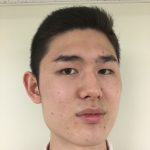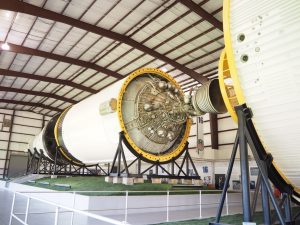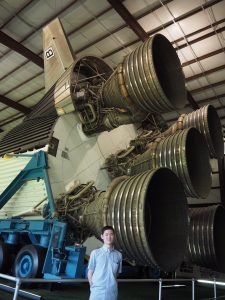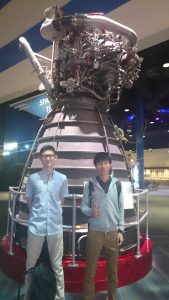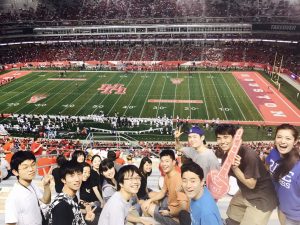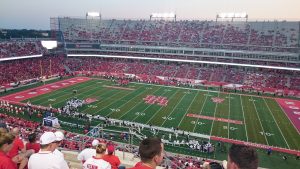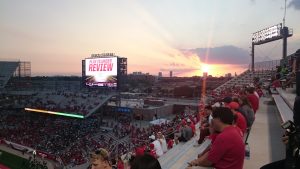Tomoyuki Sato
Home University: Nagoya University
Field of Study: Mechanical Engineering and Aerospace
Status: B3 Expected Graduation: March 2019
Research Host Lab: Prof. Tayfun Tezduyar, Department of Mechanical Engineering
Research Project Title: “Structural Mechanics Analysis and Shape Determination of the Orion Spacecraft Drogue Parachute” (PDF)
Why Nakatani RIES?
I have two reasons for participating in this program. First, I would like to see and understand various values of people in the U.S. Through my past experiences, I learned what kind of skills and abilities are necessary in working in the multi-cultural environment and found it was great fun to be exposed to new values, see the differences from my own values and discuss at which points we can compromise when collaborating. In this internship in the U.S., often referred to as a melting pot, I can work with more diverse people than any other countries; and this experience will surely let me review my own values and broaden the potential to accept values I have never seen.
Secondly, as for why I wish to join in this program as an engineering student, I would like to see the cutting-edge research and technologies, and feel the atmosphere of an American research laboratory of aerospace engineering. This is because the U.S. is one of the most advanced countries in aircraft industry and the results of engineering research are actively applied in the industry technology. So I expect to see what kind of research is necessary to solve the problem of current aircraft. Also, because Rice University is ranked 15th in the U.S. according to “Best colleges” in 2017 by U.S. News & World Report, I am interested in seeing the atmosphere of the university which must be different from that of Japanese universities. Therefore, I wish to join in this internship.
- To experience the cutting-edge technology of flow analysis utilizing CFD (Computational Fluid Dynamics).
- To check how the knowledge I obtained in Japan is/can be applied for the research.
-
To know what kind of research is focused in academic field and is necessary for aerospace industry under the status quo.
-
To watch an American football game.
Excerpts from Tomoyuki’s Weekly Reports
- Week 01: Arrival in the U.S.
- Week 02: First Week in My Research Lab at Rice
- Week 03: Interview with a U.S. Researcher
- Week 04: Reflections on English Language & Life in the U.S.
- Week 05: Research in the U.S. vs. Research in Japan
- Week 06: Final Week at Rice & Research Poster Presentation
- Week 07: Visit to Lehigh University
- Final Report & Tips for Future Participants
Week 01: Arrival in the U.S.
On August 14th, I had two lectures; one was about the problem pf life-science in the 21st century and the other was about career management and transferrable skills required for researchers working with people from different countries. Specifically, the second one was interesting for me because it told me what kind of skills will be necessary in the future from the perspective of PhD students and workers. Prof. Iida, the presenter, says the skills are leadership, communication skills, team management skills, and human management skills. Though due to lack of time, he didn’t tell me how to master these skills, but I think I understood the importance of them; in order to solve problems of this century, worldwide cooperation is inevitable. And to maximize the benefit of cooperation, there must be a lubricant which will make human relationship smoother because different people have different values; especially if they are from different countries and have different cultural backgrounds. This lecture reminded me of these essential skills.
After I flew to the U.S. and spent a few days in Houston, I got an impression; friendliness and aggressiveness. As for friendliness, every time I use a bus or taxi to the university, the drivers talked to me like “Hey, how are you doing?” and conversation starts. Or, every time I get on an elevator with someone or hotel staff, they talk to me and ask about how I fell about Houston or what I study at the university. Though I knew people in the U.S. are friendly and talk a lot, As for aggressiveness, I learned nothing will come to me unless I ask somebody to do it. For example, when I go to Rice University in early morning, I had to ask the receptionist of the hotel to arrange a bus or taxi for me. Also, when I cook in my room, I had to ask for the kitchen goods, or nobody brought them for me. Perhaps in Japan, the hotel prepares them already before the guests come to the hotel. So, I felt a great necessity to do everything by myself and I guess this is one of the reasons why Americans get used to talking to somebody even if they don’t know each other.
On August 17th, I learned more about how to apply for and get a PhD and academic career paths after completing a PhD. Prof. Kono, the presenter, says graduate school in the U.S. is more like being hired by a professor rather than just working and studying in the laboratory. And this is the reason why students do their best so that they will not be fired. Needless to say, it is very tough to pass the qualifying exam in the 1st or 2nd year of the program to keep progressing through the program, and then defend for your master and PhD. I thought this relationship between students and laboratory seems rational to make results and keep students motivated. From the lecture of Prof. Iida in Tokyo, I learned that many of Japanese students who receive master’s degrees stop doing research unfortunately. Instead, they focus on getting a well-paying job because completing a master course as well as doctoral course in Japan costs a lot. The environment in the U.S. where students can get “salary” from professors must be attractive. Since it is difficult to change the Japanese system of graduate school completely, the choice to . In addition, in order to understand what it is like to do research abroad, Japanese students should be aggressive to join in program like Nakatani-RIES Fellowship.
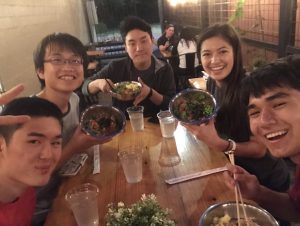
Also, Prof. Kono told me about career opportunities after getting PhD. I have thought it was natural to get a job, but he explained about other paths to stay in graduate school and continue research. Since it is not necessarily true that I can do the same research under same environment of companies, staying in the academic research field is actually a good choice.
After all the orientations, I had my first weekend in the U.S. I spent most of the time for working at my laboratory and practicing some software and OS. As this is my first time to join a research laboratory and to touch those computer programs, I had to take a lot of time to get used to them. Compared to how my friends spent weekends, it was not gorgeous weekend. However, I think I understood what it means to work as a master or PhD student.
Preparing for Research in the U.S.
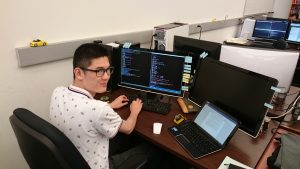
While I was in Japan, I had communication with my mentor, Mr. Tanaka to prepare for my research in the U.S. He gave me the overview of the project I would engage with and told me what kind of skills and knowledge would be necessary. My research is about a special type of parachute and in order to conduct analysis of the parachute structure and air flow around it, I had to study the basic concept of Finite Element Method (FEM). FEM is a method to cut complex shape model into pieces, focus on each, and calculate values of each element. Since this was my first time to study FEM, I borrowed some books from a city library on it.
In addition, Mr. Tanaka and Prof. Tezduyar recommended a textbook on Fluid-Structure Interactions, which is also an important concept to conduct my research, so I read through a part of the text as well. Needless to say, the details of the books and texts were too complicated and difficult for me to understand everything in 2 weeks. However, according to Prof. Tezduyar and Mr. Tanaka, it was not necessary to understand everything beforehand. My advice to future students who join in this program that “the first thing is to try to understand what the research team has done so far and the second thing is to think where in the whole project your research is located.”
This was not everything I did to study prior to departure. Since the data used for the visualizing software is written by a computer language which I’ve never used before, I had to practice this software. In addition, because the operation system of the computers in the laboratory is not what I use often, I had to install the environment first and type some commands by myself to get used to it.
Thus, when it comes to give advice to the next Nakataki-RIES Fellowship students, I will give 3 tips. First is “try to do all the things your mentor or professor gave for your pre-study.” Since the preparation for the laboratory is right after the examination in Japan, you cannot give a lot of attention to this. However, at least after all the exams, you should do your best to read through the materials. Though you may have some time during the pre-departure sessions or on the plane to the U.S., since the environment will change, you should be prepared at home well. Second is to “try to list and keep things you couldn’t understand in the texts or paper.” This is because the list of questions can be helpful for the explanation in the poster session and when it comes to be in shoes of those people who are not familiar with your own field. So, if possible, I want you to make a list of your problems and questions. And third is the simplest; “ask a lot of questions if you get any problem.” Asking questions will not only help your understanding but also help your mentor and professor to know your understanding. And without saying, deeper understanding will help you to imagine what you are going to do at Rice University and why that research is important.
The research time at Rice University is 4 weeks, but this is not as long as you expect. Better preparation will make the research more interesting.
Question of the Week
Sometimes I see Americans, maybe they are friends with each other, doing “special hand shake” like dancing. Why do they do such a thing? And when did they decide to do that hand shake?
- Yes, sometimes certain groups of friends will come up with a special handshake or greeting. It really varies by friend group and is just usually a fun way of saying hello to each other. It’s usually something done by students, for example a group of elementary school or college-age friends, but is not very common as you get older. However, some organization like fraternities, sororities, or other ‘secret societies’ may have a special greeting or handshake that all members use with each other. The most common way to greet someone in the U.S. is to just say “Hello” or ask “How are you doing?” and/or to shake hands. For more, see the section on Greetings in the U.S.
Week 02: First Week in My Research Lab at Rice
August 17 was my first day in the lab. All the members of Team for Advanced Flow Simulation and Modeling, T*AFSM, welcomed me nicely and, after individual self-introductions, my mentor showed me the desk and computer that I will use during this program. He demonstrated me some basic things, such as how to log in to the computer and use various applications. Though it was not a big welcome ceremony, I felt the team members are very concentrated and they told me that they are going to have a welcome party with new comers including me. Personally, I am used to bowing when I introduce myself, and I did this time as well. Thus, it seemed weird that other members didn’t bow to me.
Before I left Japan, I had heard the teammates of T*AFSM don’t talk to each other in the lab and use text messages, but actually, they talk to each other and give advice on projects they engage, and rarely use text messages or e-mails.
My mentor is a Japanese graduate student who came to Rice University as a visiting graduate study researcher. Basically, he and I talk in English and he gives me tips and guide me through the project. For example, he taught me many commands of a computer language and of an OS, and showed me how to use programs using these commands. Thus, he is very good at computer manipulation, and his manipulation is super-fast and precise. Moreover, his way of teaching is also so good and kind enough that he explains things to me many times changing expressions unless I clearly understand. Every time I call him for questions, he will soon tell me how to deal with the problem and tell me why the solution is workable.
I talk with my teammates as well. It’s not so many times, but they tell me interesting stories or information which are so helpful for me to deal with the new programming language and operating system more smoothly.
Since I’ve been in the U.S., I use English in my daily life including in the lab. My English seems to make sense to both native and non-native English speakers, but I found my explanation using English tends to be longer and use more complicated grammar than necessary; this can be confusing for listeners. This may not be the problem of English but the problem of my general speaking ability, so I felt I should pay more attention how I speak and try to shorten the explanation using precise words and idioms in English as well as Japanese.
In addition, I feel a great necessity to improve my listening ability. The U.S. has various kinds of people who speak English with different accents. The intonation, accent and kinds of words they use are sometimes slightly different and sometimes completely different, and I had to say, “Pardon me?” or “I don’t get it. What do you mean?” many times. However overall, I think it is a very important and essential experience and be exposed to different ways of speaking English in order to work with people who have different cultural backgrounds and speak English differently in the future.
On August 22, I had a lecture about poster presentation which was very compelling. Though I belong to English Speaking Society, ESS, an English-speaking club since senior high school and I am used to delivering English speech and presentations, I found poster presentation were completely distinct from my prior experience. In case of presentation, since the audience is far from the presenter, less important sentences should be avoided as much as possible, and pictures or illustrations are recommended. However, in case of poster presentations, since presenter and audience stand very close, the poster can be a great source to deliver information to the audience. Thus, it should be succinct enough to understand the content of the project but should be beautiful enough to attract your audience. Without saying, poster presentation is not only about posters. I cannot wait the next lecture which is about how to speak to the audience at the poster presentation.
I also participated in other school events. On August 21, I went to see the solar eclipse. Though it was not full eclipse, it was beautiful. On August 22, I joined in “Free-Cycling Supplies of Office”, a so-called flea market. There, I got this keyboard which I’m using to write this article. In the market, there were so many books, stationaries, binders and electro-devices. It was a new experience for me to join in a university recycling event like this. Finally, I also joined in an event in which many clubs of Rice University get together and host tables about their activities. Although I couldn’t look at each club’s table deeply due to lack of time, I could feel the enthusiasm of the students there. I’ve never experienced this enthusiasm before.
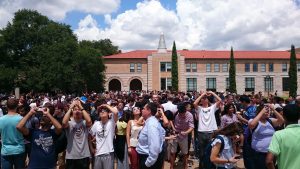
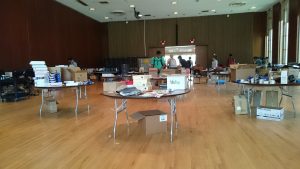
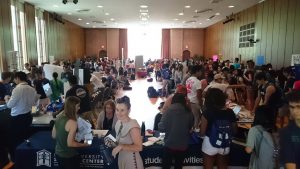
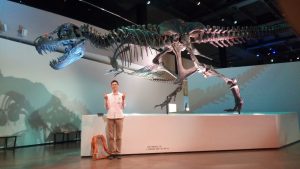
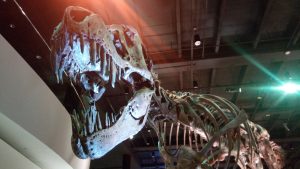
Research Project Update
My project is about a parachute and its stabilization. My team approximates the movement of parachute as a certain function which assumes the movement of the parachute will attenuate as time goes. And, from the function, we get 2 parameters to control (let me say A and B here). And, those 2 parameters can be replaced to another 2 parameters (C and D), parameter C can be fixed and D is variable. My goal is to find the linkage between the number of the variable parameter and the movement of the parachute running computational simulation for each parameter.
My method for research has 3 steps. First, I choose one number for parameter D and calculate parameter A and B using fixed number C. Second, from the number of A and B, I will complete the program for computation. Third, my mentor will run the program. Fourth, my mentor and I will visualize the result of the simulation and check whether the parameter D was proper or not. If it is improper, I will change the parameter D and start all the process from the beginning.
Since all the computational calculation can be done on the computer, my experiment equipment is just one computer. However, I have to use it with a different operation system and a different computer language from the ones that I use often. Thus, I didn’t need any training for research but needed to understand how to use commands and write programs under the OS.
As I already started to take results of some cases, my mentor and I am shifting to arrange them into graphs and pictures for the poster. Without saying, additional computations are necessary, so I will focus on those two things in the next week.
Question of the Week
I wonder why American students study so hard and, on the other hand, can join in events and club activities. Why are they so good at time management? (I cannot do that… but I want to be like that!!)
Week 03: Interview with a U.S. Researcher
I had an interview with Professor Andrew Meade in the Department of Mechanical Engineering at Rice University, and he answered my questions as follow:
About his career:
Q1: What is your career path?
A1: I am a full professor at Rice University. I plan to continue contributing to my field through undergraduate and graduate education, supervision of graduate students, production of research journal papers, conference papers, and conference presentations.
Q2: Why did you decide to study in the field of Aerospace Engineering, and in the field of CFD?
A2: I wanted to help in the production of future aircraft and the solution of interesting technical problems. I also wanted to help increase the accuracy and usability of computational fluid dynamics tools.
Q3: What is it like to be a researcher in the U.S. or at Rice as compared to your home country or prior university?
A3: Rice University is considerably smaller than the University of California at Berkeley. I work more closely with researchers from other departments much more than I did at Berkeley.
Q4: What was the biggest challenge for you so far?
A4: Being in charge of the department of mechanical engineering and the aerospace educational program as the department chair.
About his lab:
Q5: How does working in a lab at Rice or the U.S. compared to any prior experience you have with other research lab environments?
A5: Research was more streamlined where I previously worked, at NASA Ames Research Center. The personnel were only concerned with experimental or computational research. Universities are more fulfilling in that they also include the education of students and the use of research results in course work.
Q6: How diverse is your current lab environment at Rice in terms of gender, research fields, and international students?
A6: I have had male and female students from multiple countries. Presently, my lab is all male with students from Europe and the U.S.
Q7: How has the internationalization of research impacted their work?
A7: In my time aerospace research has always been international. I have worked with other researchers from Europe and Japan.
Reflections on the Interview: The most interesting question for me was Q5; comparison of the research at Rice and the working experience at NASA Ames Research Center. As Professor Kono told me in the presentation of this program, the role of university is not only research, but to educate people. Probably this uniqueness differentiates university from other research institutes including NASA.
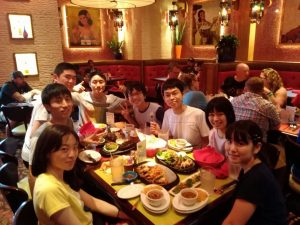
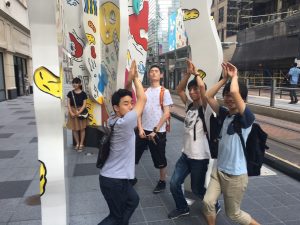
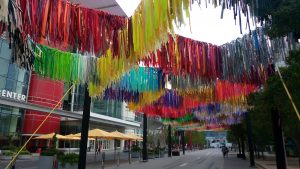
Research Project Update
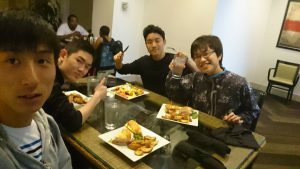
Though Tropical Storm Harvey came and Rice University was closed for a week, I could still connect my laptop to the lab’s server and did some work at the hotel. Since my PC cannot do huge calculations, all I was able to do was:
- Download a data file, which is about the movement of the parachute, and made a graph of it.
- Calculate the frequency of the oscillation of the parachute from the graph.
After these I completed these two tasks, one of my supervisors decided to shut down the server for safety; just in case of the power went out or if there was a power surge as this could damage the server. Therefore, I couldn’t do any more remotely until the serve was restarted on Thursday. Instead, I started to think about the framing and the content of my final poster. Though it was just a while, it was quite interesting to be able to work even out of the workplace and still make progress with my resaerch.
Question of the Week
I see some people wearing a uniform of military with a badge saying “AIR FORCE” or “NAVY” on it. I suppose they are real soldiers, but why are they in campus? Do they study something at Rice?
- They may be members of Rice’s Navy ROTC unit.
- The U.S. military actually offers a wide array of educational benefits with the specific names of these educational programs varying to some degree among the different branches. For example, there is also an Army ROTC program.
- The Department of Defense also funds scientific and engineering research through their various agencies and research labs including:
Week 04: Reflections on English Language & Life in the U.S.
I have a confession. In past years, I always had great confidence in my English-speaking ability, specifically my pronunciation of English. And, I believed better pronunciation would be more professional, bring more confidence, and above all, it would identify myself in terms of English competency. However, after coming to the U.S., I have felt something going away from what I expected. It’s not like what is often said “English is a tool” or “If what you say makes sense, you don’t have to worry at all.”
Because I have been a member of E.S.S., English Speaking Society, since senior high school, it is not a problem for me to talk to or speak with somebody in English wherever and whenever. Though it is true that I don’t know a lot of terms of aerospace engineering and cannot hear and understand what my teammates say, I don’t feel any difficulty in conversations in my lab and in daily life.
Then, where is my uncomfortableness coming from? When I have few problems in conversations I pay a lot of attention to my pronunciation. I am passionate about making my English more sophisticated. But even now, the problem seems to have something more to do with how to speak than what to speak. Probably, the uncomfortableness is not coming from the pronunciation, but from the other things of how I speak. And this makes me feel that something of my English is weird or “something is getting away from me”.
To get a learn from this experience, let me explain what I’ve experience and what I’ve learned from it. As I wrote earlier, E.S.S. is my club activity and particularly, I am a member of its debate section. My debate career started with my ESS career, and I get became used to the way of delivering a speech in my debate matches. This is one of the biggest reasons why I have less hesitation to talk in English, but the thing is that I got used to the debating way more than necessary, and it’s now difficult for me to talk conversationally. 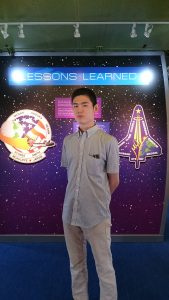 Almost all the time, I think about the consistency of my words and opinion, and what is more, I strive to talk flawlessly like a TED talk. On the other hand, every time I’ve gotten stuck in a conversation, looking for words, I get embarrassed a lot and get disappointed in myself. These negative feelings get stuck in my mind and sometimes come back to me. Afterwards, I feel hesitant to join in on the next conversation. Even though I am confident enough, this is what comes after I joined in a group and started talking, confidence seems powerless for my problem.
Almost all the time, I think about the consistency of my words and opinion, and what is more, I strive to talk flawlessly like a TED talk. On the other hand, every time I’ve gotten stuck in a conversation, looking for words, I get embarrassed a lot and get disappointed in myself. These negative feelings get stuck in my mind and sometimes come back to me. Afterwards, I feel hesitant to join in on the next conversation. Even though I am confident enough, this is what comes after I joined in a group and started talking, confidence seems powerless for my problem.
After thinking about this problem, I’ve come up with a possible solution. The reason why this tendency got stronger may be because I have now had more opportunity to talk in English in the U.S. than I had in Japan. Therefore, the first and the most effective solution is to go, join in a group and talk as much as possible until I feel I get used to the “free” talking style. Needless to say, I will get stuck many times and feel uneasy, but this hardship is inevitable and worth overcoming to be the type of English speaker I would like to be.
“I am not discouraged because every wrong attempt discarded is a step forward.” This is a saying of Thomas Edison. I better understood the true meaning this week.
NASA: Space Center Houston Photos
Research Project Update
I had a big change this week. Actually, my project had 2 directions to go in terms of the number of parameters used in an equation. As we conducted simulations changing one of them, we found the parameter was not effective to reach our goal; to shorten the computation time of shape determination to obtain an initial shape for Fluid–Structure Interaction. That is why we changed the research direction to the other way and conducted computations again after the hurricane.
Our conclusion is that the second parameter was the key actually, and we reached a certain level of conclusion this week. Then, my mentor and I conducted some additional computations to get more data to lead my project to a full conclusion. We also made graphs and took some screen shots to check our conclusion.
From Thursday or Friday, we started making my poster. We set a goal to make a draft until next Monday so that Prof. Tezduyar could check the contents and the linkage among them. Since the deadline of the poster is postponed to next Thursday, I think I will have plenty of time to complete it. In addition, my mentor suggested that I check it several times! Thank you, Mr. Tanaka. I will do all I can!
Like how I got a conclusion in my research project, , my 4 weeks in the lab taught me a lesson. It is “Have a willingness to conquer any hardship. There, you can find a way forward.”
When I was in Japan, before coming to the lab, my mentor gave me a lot of tasks to do. As I wrote in the earlier reports, I had to study and get used to a new computer language, new operation system and new subjects. Everything was completely new, and what is more, I didn’t have enough time to do everything. To tell the truth, I couldn’t finish them all. I still have many pages of my Python textbook and many concepts to understand about Structural Mechanics Computation. This is also the case even after I came to the lab. It was almost like hell for me because all the programs are written based on what I should have become accustomed to while I was in Japan. Though it is true that the lab life is fruitful and I enjoy it now, the days full of feeling “I should have done this and have done that…” were not pleasant.
However, it is also true that I can continue to work on them in the U.S. as well. As the working hour of my lab starts at 8 AM and ends at 5 PM, I can use half and an hour or 2 hours before and after the working time and Saturday and Sunday as well. Sometimes I made some data, and sometimes I made graphs and videos after working hours when I couldn’t make them during the day. Those days are not easy and I feel powerlessness of myself, but feeling powerlessness means that I am tackling the problem and trying to improve my skills and obtain new knowledge at the same time.
Even now, I cannot build up programs using the new language and I don’t understand many concepts fully. However, I believe if I continue to practice and study, always keeping the willingness to conquer difficulties in my mind, the day will definitely come at last when I use the language like my hands or fingers and when I understand the concepts and even think of applications of them. The day may not be close, but it will come. Therefore, though the famous quote says “Failure is not an option”, in my case, “Running away is not an option”.
Week 05: Research in the U.S. vs. Research in Japan
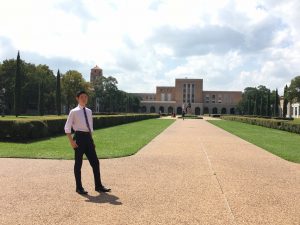
I learned that graduate students in US labs work hard because they get a salary from the host professor and because they have to give research updates continuously. I found this was correct after I started working in the lab. Students in my lab, come to the lab at specific time and start working. When a member gets in trouble, he asks questions to the other students and they try to solve the problem together. Also, when they have different opinions or solutions, they actively discuss what is the core of the problem and therefore what would be the best solution for the problem. As the human relationship is fairly flat in my lab, master students actively give opinions to Ph.D. students. They are more of a team rather than a gathering of individuals. It goes without saying, that I was helped so many times not only from my mentor, but also from other members of my lab. They taught me things until I fully understand what they were saying, and sometimes, even after they left the office, they still answered my questions by texts. Though it is often said that the US is a country that prioritizes individualism unlike Japan, I felt this is not the case; at least in my lab.
When I come to think about what is valued in terms of academic research in the U.S., let me borrow the words of my professor. “We are not interested in things that everybody can do. We are interested in something challenging.” I think this shows everything. One of the main research themes of my host lab is the analysis of parachute movement. Since parachutes are made of a flexible structure, when we compute how it moves, we must take into account the interaction between the parachute structural deformation and the airflow around the parachute. This computation is very complicated and takes a long time. Probably, this is a perfect reason to tackle this problem for my professor. Since I have no experience to join in and present my research in conference, I cannot tell what kind of research is important and what is not. However, something challenging will always bring something new. Something new will bring new benefits, new discoveries and excite people. I believe this is the reason why something challenging is valuable in the academic field.
This summer internship was full of new discoveries. I cannot write about every single lab episode here, so let me give you one lesson I obtained through these five weeks. As I wrote in the Week 4 report, the lesson is “Have a willingness to conquer any hardship. There, you can find a way forward.” This lesson may be applicable whenever you have something to achieve. My research experience taught me how tough this is but also how important it is to struggle as much as I can under a circumstance full of tasks and full of despair due to my limited knowledge and experience in this research field. Because I think this lesson comes from the unique environment of the US, I desire to come back here and pursue graduate study in the U.S. in order to put myself in a harsh environment and to make myself struggle again. Also, since the US is one of the best countries for the aerospace industry, I am happy if I can work in the country.
What will I miss most about working at Rice and living in Houston? With no doubt, my lab teammates, huge hamburgers and pizzas, and football games.
All my internship was beautifully planned by my mentor. As my mentor explained the whole plan of research to me before I left Japan, I made up my poster on Thursday or Friday and even had plenty of time to prepare the script for the poster session. Friday afternoon, all my teammates listened to my poster talk to practice for the questions and answers. Probably I can focus on the practice every day next week.
On Saturday, my teammates had a little bit late welcome party for me and some other new comers to the lab. We went to a sushi bar. The restaurant had strange menu specifically of rolls, but I enjoyed a lot. Compared to Japanese sushi, the price was around double.
I think my research has a wider range of applications than I expected. Without doubt, if the past methods are useful and if we can reach a conclusion with them, we should use them continuously. However, there are many cases in which these methods take a long time or cost a lot due to many trials. On occasions where computational analysis is applicable, we need to shorten the time for trials and reduce the cost. Though computation itself takes time, it’s much faster than the original, experimental methods. Let me explain using the example of the drogue parachute of spacecraft Orion. The parachute is actually very big and we cannot bring it into a wind tunnel. Unfortunately, even if we try to make a smaller scale of the parachute, there’ll be a limitation for the thickness and weight of the materials and there is also a limitation on the wind velocity. On the other hand, if we do a real-world, drop test, we have to wait for a good sunny day with almost no wind for every single possible design of the parachute to be analyzed. This is why computational analysis will be a good method as it is lower cost and takes less time.
Since this research has a wide range of applications, I may engage with this field in the future. However, regardless of my future, this 5-week research internship was a fruitful and enjoyable experience for me.
Attending the Rice University – University of Houston Football Game
Week 06: Final Week at Rice & Research Poster Presentation
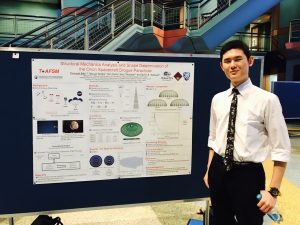 Poster session is over! Now, looking back at what happened during those 90 minutes, it seems that I didn’t have such a great difficulty to explain my research. This is probably because I spent a long time with my mentor, host professor, and TAFSM members for checking and practicing how to talk properly before an audience. In addition, as they taught me deeply on parachute FSI (Fluid–Structure Interaction) and its process in the last 2 weeks, I had enough time to organize things in my head and to understand what to say in response to questions.
Poster session is over! Now, looking back at what happened during those 90 minutes, it seems that I didn’t have such a great difficulty to explain my research. This is probably because I spent a long time with my mentor, host professor, and TAFSM members for checking and practicing how to talk properly before an audience. In addition, as they taught me deeply on parachute FSI (Fluid–Structure Interaction) and its process in the last 2 weeks, I had enough time to organize things in my head and to understand what to say in response to questions.
Thus, all I had to do during the session is to have conversations with the audience members by opening and closing drawers in my head. Though some people gave me unexpected questions about the research background and the research method, I believe I was able to use proper metaphors and examples to give in-depth answers. One thing that I was surprised at is that the number of questions. Before the session, I anticipated to have dozens of questions, but it seems that my talk was more like a presentation or a speech, which means that I focused on finishing my talk giving almost no pause. As a reflection for my next poster session, I should pay more attention to the audience and have conversations asking them “Do you have any questions so far?” after every section in the poster.
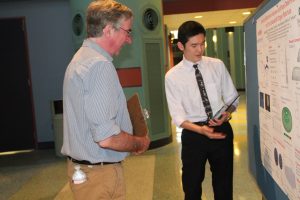
Before moving on to the next topic, there was one funny episode I want to share. A professor came to me and asked me to explain my poster. Since I didn’t know who he was at first, I started to use the same explanation that I did for those people who don’t know much about FSI or CFD (Computational Fluid Dynamics). After I finished the first half, my host professor came, and told me that the man was actually one of professors at Rice University and works on CFD, which means he understands the field much deeply than me. I got embarrassed because my explanation at that time was just like admonishing small kids. Another reflection: don’t forget to check how much the audience understands about the field.
Final Research Project Overview
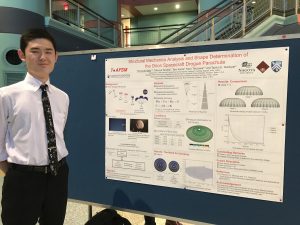
Research Project Title: “Structural Mechanics Analysis and Shape Determination of the Orion Spacecraft Drogue Parachute” (PDF)
Host Lab: Team for Advanced Flow Simulation and Modeling
Host Professor: Prof. Tayfun Tezduyar
Mentor: Tatsuya Tanaka
Introduction: My research subject is computational shape determination of the Orion drogue parachute. Orion is NASA’s next generation spacecraft following the space shuttle. Since parachute is made of a flexible structure, we need fluid–structure interaction (FSI) analysis, which takes into account the interaction between the parachute structural deformation and the airflow around the parachute. One of the reasons why FSI is challenging is because determining the starting shape in the parachute FSI is difficult. That is why in my research I focused on this shape determination process.
Approach: To reach the steady-state shape of the parachute, in the structural mechanics computation, we need to reduce the displacement oscillations. I accomplish that with Rayleigh damping, with two damping coefficients, eta and zeta, which depend on the time-step size delta t. I studied 3 cases of different delta t.
Results and Conclusion: The canopy shapes converged and we can say that the oscillations have been largely eliminated. In addition, we can say that the damping model works well in reaching the steady-state shape.
Future Research: The next step in this research is to use Rayleigh damping at different Mach numbers and altitudes and start the actual FSI analysis to improve the parachute performance.
Return to Top
Week 07: Visit to Lehigh University
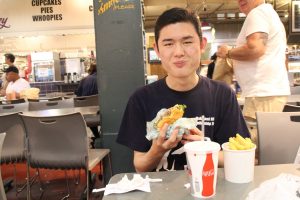
The day after the poster session, we flew to Philadelphia and visited Lehigh University. There, we had some lectures on applying for U.S. graduate schools and on personal strengths. The first one was full of useful information from various engineering and science professors at Lehigh. The panelists told me to choose schools carefully because getting a Ph.D. is not easy and takes time. Thus, I must search well on which lab is doing what kind of research. In addition, I must understand what I’m interested in now and what kind of research I want to do in the future.
- For more on this, see our page on Applying to Graduate School.
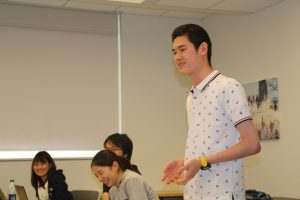
The second talk was more fun than useful. We talked about human characteristics, and based on a test, we analyzed ourselves to find out what will be our strength and weakness. It was interesting for me to find myself being a “maximizer”, which means that I’m not satisfied with being average and that I tend to focus on my strength or talent and train hard to make it excellent (maximization). The whole analysis is much longer than this, and I’m not finish reading it yet, but I thought this perfectly described me. Now I can use this result for my career!

Question of the Week
It was very interesting to analyze my characteristics at Lehigh. And, I wonder there is any characteristic of Japanese people that you think they should be careful or they should keep having when it comes to interact with non-Japanese people.
- We often advise American students that they need to learn to pause/be quiet in conversations and listen more than they speak. Speaking up is a positive thing in U.S. society but the down-side is that sometimes Americans can ‘speak over’ or ‘drown out’ other voices.
- In comparison, Japanese students often tend to wait to ‘speak up’ until they know they are 100% (or at least 95%) correct. This can be difficult in a U.S. classroom environment where professors ask questions in class and expect that students will share what they think the answer is (or what their perspective is) even if it is not correct. Japanese students can stay quiet as they may not want to give the ‘wrong’ answer but this can actually jeopardize their grade; often professors award ‘participation points’ and if you never speak up in class they may assume you are not interested or are a ‘bad’ student.
- Also, Japanese students tend to pause a lot in conversation when speaking English as in Japanese there are more natural pauses or silences in the language. However, this is not true in English so the other person may jump in to ‘help’ you by saying the word/phrase they think you are trying to remember when you pause. If you pause too much, you can come across as hesitant or weak in a conversation in English. So, not being too shy and worried about finding the 100% correct word is important. “Don’t be shy, just say what you think” is a phrase you may hear in the U.S. or sometimes people say “I’m just thinking out loud”. This means it is okay to say whatever first comes to your mind, even if it is not completely accurate or exactly the word you mean, as through conversation with the other speaker you’ll both come to a better understanding of what is meant. So, speaking up is a good thing for most Japanese students to become more comfortable doing to be most successful in a U.S. environment.
Final Report & Tips for Future Participants
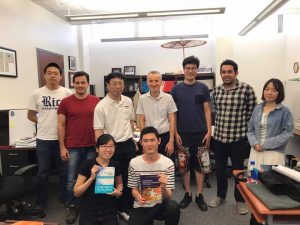
This summer, I participated in the “Nakatani Research & International Experiences for Students” program, and worked for Team for Advanced Flow Simulation and Modeling (TAFSM) at Rice University. For my final report, let me summarize the entire program into 3 parts: pre-programs, lectures at Rice, and lab life in TAFSM. Also, I will write about my motivation for future career path at the end.
First, I want to talk about the pre-program activities including Fuji, Kyoto, and Tokyo. In May, the U.S. fellows and Japanese fellows went to Fuji and, in July, to Kyoto together for cultural interactions, which were full of surprises. The most astonishing thing for me was to know that U.S. students consider studying enjoying. I noticed this when a U.S. fellow asked me a question: “Which thermal cycle do you like the most?” right after I met her for the first time. As far as I know, this is not so likely to happen among Japanese engineering students to talk deeply about thermodynamics outside the university in their daily life. Moreover, and with a doubt, it cannot happen to ask questions or even to think about likes and dislikes of the specific part of a subject. Since I saw another American student asking a similar question, this kind of conversation might be common among American students. Anyways, I think this event showed me an interesting aspect about this group of U.S. students, which is that a enjoy a sense of work and learning as being a motivation for them. Unlike me, who chooses subjects based on potential usefulness, American students choose them considering whether they are interesting or not. I’m not saying which attitude is better, but my present attitude may stop myself studying more deeply after I found the subject doesn’t have any linkage with my own research field or with my job in the future. On the other hand, however, the new attitude will let people keep learning as long as the topic is attractive to them, and they may discover something important at the end of the day. This comparison implies that taking in this new attitude will definitely change myself to love absorbing knowledge and exploring studying more; even if the topic don’t appear useful at first.
The core Nakatani RIES program started from the middle of August. Though some days our research was cancelled due to Tropical Storm Harvey, I had many interesting and helpful lectures and online seminars at Rice and Lehigh University. They covered various fields: how to make good academic posters and how to explain academic contents, the Ph.D. career in the U.S., how to increase English vocabulary, how to deal with English idioms, and so on. The most interesting lecture was about characteristic analysis and how to do an elevator pitch based on the individuals’ personal strengths. Through this lecture, I noticed that I tend to make an effort to transform something strong into something superb. In addition, I do my best work when somebody truly recognizes my talents, and I want to be appreciated for the talents, skills, and knowledge I have acquired. Thanks to this detailed analysis, I have learned more about what kind of person I am, what kind of possibilities I have in the future, and above all, how to change myself. I’m sure that I will spend more time cultivating my unique gifts and seek a place where I can utilize them. Not only in the rest of my university life, but also when thinking about my future career. Following this analysis, I can find a company or laboratory in which I can utilize my strengths fully, work for those people who evaluate my talents well, and continuously maximize the contribution. And, without saying, this lecture suggested me to seek the strengths that I haven’t realized so far but still have huge room to improve.
Though my life in Houston was extraordinarily full of fun memories, I would rather like to emphasize how fruitful my lab life was when speaking to my friends, family and professors. Since my research is fairly complicated, I’m won’t write about it in detail here. Instead, let me write about the lessons I obtained through my life in the lab. Though it’s simple and quite common, “Have a willingness to conquer any hardships”.
My research started before going to the U.S., with tons of things to remember. Because I had never used Linux and Python, I had to grow accustomed to their environment, commands, codes, and the functions. In addition, I had to comprehend the concept of Finite Element Method (FEM) which would be an important pillar for Fluid–Structure Interaction (FSI) or Computational Fluid Dynamics (CFD), in other words, computational simulation and modeling. Furthermore, though it’s obvious, additional commands, concepts, and etcetera came to me during the program. To be honest, I had some days when I got disappointed and wanted to cry for my lack of knowledge of the field. Though some people cheered me up saying that it might be better not to expect a certain result through this program, I didn’t want to agree with them and give up doing my best. Above all, I desired to give contributions for my mentor, host professor, and TAFSM members for teaching me a lot. That’s why I tried to spend as many hours as possible to practice the computer programming and to review each process toward FSI. Looking back now, though I’m still not good at technical things, my decision at that time seems correct because I can now build up Python codes, deal with the Linux environment, and explain what FSI, CFD, and my research was like.
Considering that I had another choice to keep the status then, I can summarize that it is indispensable to try to get over the hurdle in order to achieve success even if it is daunting and even if by trying you make no remarkable results at the end. This is why I want all the people who read this report to approach research with a willingness to conquer hardships.
By the way, my research was computational shape determination of Orion drogue parachute, which aims to find the condition that can shorten the computation time to determine the starting shape for symmetric FSI. This research will contribute for the better parachute performances, including stability.
Though this is not everything, this is all I learned through the program and want to tell everyone about my experience after coming back to Japan. It is clear that this program changed me drastically and gave me a chance to crystallize my future career. I thank Nakatani foundation for giving me such a great chance this summer. And… I’ll be back.
Final Question of the Week
I heard one student has several research themes at the same time in lab. Is this true? Are those themes different completely?
- It varies by lab and project. Sometimes, there can be multiple tracks that a student is exploring as the lab really doesn’t know which one will work or what to expected. This is more common in basic experimental research though it can happen with applied research too. It is most likely to happen for a graduate student who has a long time to spend in the lab and therefore can explore multiple ‘threads’ of research. For short-term research students, this is less common but can and does happen if they research question is one where they can be multiple possible answers or things to try.
- It can be very challenging/difficult for a young graduate student to manage multiple research threads/tracks so being successful at this type of research requires very good time-management, organization, and communication skills to be able to keep your mentor/s and professors advised about how multiple research projects are progressing at the same time.
Follow-on Project Plan
I would like to give a presentation about the program. And before the presentation, I’m planning to put flyers on bulletin boards in Engineering buildings and at the Office of International Affairs. If possible, I would like to give the presentation to the President of my university so that the program will be advertised by the whole university, but I’m not sure whether it is possible or not.
